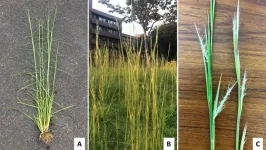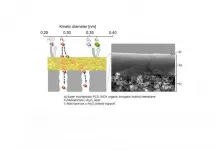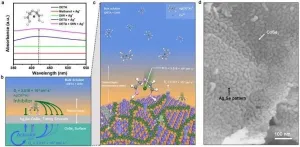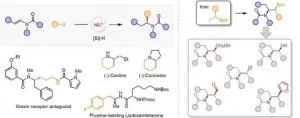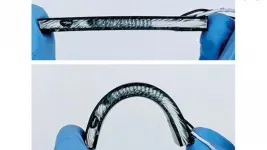(Press-News.org) Native to the southeastern United States, a weedy grass has spread northward to Canada and also made its way to Australia and Japan. Andropogon virginicus grows densely packed and up to seven feet tall, disrupting growth patterns of other plants and competing for resources. When burned, it grows back stronger. There is no way to effectively remove the weed once it has invaded. But there might be a way to use it to human advantage.
An international team of researchers has found that A. virginicus extracts appear to be effective against several human diseases, including diabetes and cancer. The results were published on Dec. 31, 2020, in a special issue of Plants, titled "Biological Activities of Plant Extracts."
"A. virginicus is an invasive weed that seriously threatens agricultural production and economics worldwide," said paper author Tran Dang Xuan, associate professor in the Transdisciplinary Science and Engineering Program in the Graduate School of Advanced Science and Engineering at Hiroshima University. "However, no solution efficiently utilizing and tackling this plant has been found yet. In this paper, we highlight the potential application of A. virginicus extracts in future medicinal production and therapeutics of chronic diseases such as type 2 diabetes and blood cancer, which can deal with both crop protection and human health concerns."
Researchers found high levels of flavonoids in the samples they extracted from the weed. These plant chemicals have significant antioxidant and anti-inflammatory properties, according to Xuan. When tested against a variety of cell lines, the extracted plant chemicals bonded to free radicals, preventing damage to the cells. At skin level, this helps prevent age spots by inhibiting a protein called tyrosinase. Among other, deeper healthful actions, this bonding also helps prevent knock-on cellular actions that can lead to type 2 diabetes.
The team also specifically applied the extracted chemicals to a line of chronic myelogenous leukemia, a rare blood cancer. The extract appeared to kill off the cancer cells.
Xuan said the researchers plan to establish a comprehensive process to isolate and purify the compounds responsible for known biological properties, as well as work to identify new uses. They will further test the therapeutical effects of the compounds, with the eventual goal of preparing functional pharmaceuticals for human use.
"Although A. virginicus has been considered a harmful invasive species without economic value, its extracts are promising sources of antioxidant, anti-diabetic, anti-tyrosinase, and antitumor agents," Xuan said.
INFORMATION:
Co-authors include La Hoang Anh, Nguyen Van Quan and Yu Iuchi, Transdisciplinary Science and Engineering Program in the Graduate School of Advanced Science and Engineering at Hiroshima University, Japan; Vu Quang Lam and Akiyoshi Takami, Division of Hematology, Department of Internal Medicine, Aichi Medical University School of Medicine, Japan; and Rolf Teschke, Department of Internal Medicine II, Division of Gastroenterology and Hepatology, Klinikum Hanau, Teaching Hospital of the Medical Faculty, Goethe University Frankfurt, Germany.
About Hiroshima University
Since its foundation in 1949, Hiroshima University has striven to become one of the most prominent and comprehensive universities in Japan for the promotion and development of scholarship and education. Consisting of 12 schools for undergraduate level and 4 graduate schools, ranging from natural sciences to humanities and social sciences, the university has grown into one of the most distinguished comprehensive research universities in Japan. English website: https://www.hiroshima-u.ac.jp/en
Hydrogen has been hailed as the 'fuel of the future' owing to several reasons. First, compared to the conventionally used hydrocarbons, hydrogen exhibits higher energy yield. Second, the commercial use of hydrogen fuel, which yields only water as a byproduct product, would help mitigate the imminent global warming crisis by reducing the use of exhaustible and polluting fossil fuels. Thus, ongoing research has been focusing on efficient and environment-friendly ways to produce of hydrogen fuel.
Solar hydrogen production through photoelectrochemical (PEC) water-splitting reaction is an attractive "green" method of ...
Research from the University of Kent predicts an end to deregulated competitive pubic transport in the UK as a consequence of Covid-19 social distancing measures leading to drastically reduced ridership, requiring a major rethinking of the provision of public transport.
This paper, published in Transport Policy, argues that the situation will require a fundamental approach to long-term policy for transport as a whole. This is an opportunity to reconstruct the system whilst addressing such problems as the environmental impact of transport, congestion and questions of transport justice such as accessibility ...
A new substance could improve the treatment of persistent cancers. Researchers at Martin Luther University Halle-Wittenberg (MLU) and the University of Greifswald have developed a new inhibitor that makes drug-resistant tumour cells respond again to chemotherapy. The new substance blocks a protein in the cancer cells that normally transports the cancer drugs back out of the cells. The results were published in the scientific journal Molecules.
In addition to radiation therapy, cytotoxic agents, also known as chemotherapy, are frequently used to treat cancer. They prevent cells from dividing and thus cancer cells are unable to multiply unchecked. "Cytotoxic agents remain a very important form ...
In 1952, Alan Turing, the father of computer science and artificial intelligence, proposed that certain repetitive natural patterns may be produced by the interaction of two specific substances through the "reaction-diffusion" process. In this system, activator promotes the reaction and inhibitor inhibits the reaction. When the two meet, the reaction diffuses. When the difference in diffusion coefficient between the two reaches a certain level, the high diffusion ratio between them will cause the system imbalance and induce the formation of periodic complex patterns.
"Turing structure" exists widely in nature, such as the body patterns of zebras, the phyllotaxis of sunflowers, the follicle spacing of ...
The precise choice of treatment for breast cancer depends upon the status of the hormone receptors (for oestrogen and progesterone). Their conventional determination by means of immunohistochemistry (IHC) is associated with a certain error rate, which can be reduced by adding genomic data. Even conventional statistics can bring about a notable improvement but now it is possible to use decision theory to optimally combine diagnostic findings, particularly where they are contradictory. This is the finding of a recent study conducted by MedUni Vienna under the leadership of Wolfgang Schreiner from the Center for Medical Statistics, Informatics and Intelligent Systems (CeMSIIS). The methodology has applications way beyond breast cancer and can be deployed ...
Recently, research group, led by Prof. FU Yao and associate research fellow LU Xi From Hefei National Laboratory for Physical Sciences at the Microscale and School of Chemistry and Materials Science of the University of Science and Technology of China (USTC), has made significant achievements in the field of synthesis of chiral amines. They developed a mild and general nickel-catalysed asymmetric reductive hydroalkylation and realized the modular synthesis of chiral aliphatic amines.
Results were published in Nature Communications on Feb. 26, 2021.
Chiral amines are important chiral auxiliaries and key synthetic intermediates of pharmaceuticals and natural products. ...
With the help of the European Southern Observatory's Very Large Telescope (ESO's VLT), astronomers have discovered and studied in detail the most distant source of radio emission known to date. The source is a "radio-loud" quasar -- a bright object with powerful jets emitting at radio wavelengths -- that is so far away its light has taken 13 billion years to reach us. The discovery could provide important clues to help astronomers understand the early Universe.
Quasars are very bright objects that lie at the centre of some galaxies and are powered by supermassive black holes. As the black hole consumes the surrounding gas, energy is released, allowing astronomers to ...
Astronomers using the National Science Foundation's Karl G. Jansky Very Large Array (VLA) and Very Long Baseline Array (VLBA) have found and studied the most distant cosmic jet discovered so far -- a jet of material propelled to nearly the speed of light by the supermassive black hole in a quasar some 13 billion light-years from Earth. The quasar is seen as it was when the universe was only 780 million years old, and is providing scientists with valuable information about how galaxies evolved and supermassive black holes grew when the universe was that young.
The studies indicate that the quasar -- a galaxy harboring a black hole 300 million times more massive than the Sun -- has a jet of fast-moving particles only about 1,000 years ...
COLUMBUS, Ohio - Multinational companies headquartered in countries with tougher environmental policies tend to locate their polluting factories in countries with more lax regulations, a new study finds.
While countries may hope their regulations will reduce emissions of carbon dioxide and other greenhouse gases, these results show that these policies can lead to "carbon leakage" to other nations, said Itzhak Ben-David, co-author of the study and professor of finance at The Ohio State University's Fisher College of Business.
"Firms decide strategically where to locate their production based ...
North Carolina State University engineers continue to improve the efficiency of a flexible device worn on the wrist that harvests heat energy from the human body to monitor health.
In a paper published in npj Flexible Electronics, the NC State researchers report significant enhancements in preventing heat leakage in the flexible body heat harvester they first reported in 2017 and updated in 2020. The harvesters use heat energy from the human body to power wearable technologies - think of smart watches that measure your heart rate, blood oxygen, glucose and other health parameters - that never need to have their batteries recharged. The technology relies on the same principles ...
